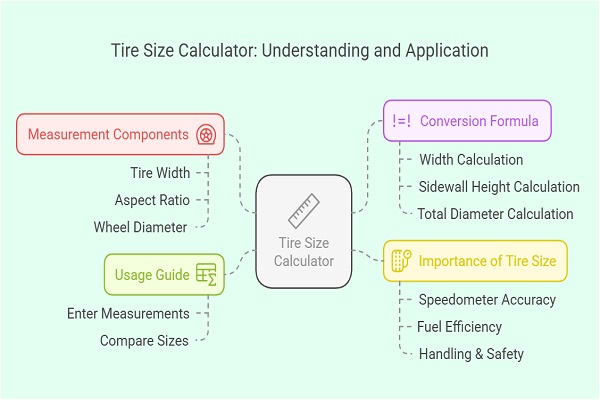Tire Size Calculator (Imperial)
© Imperial Calculator Ltd
Disclaimer: All Converters in the Imperial Calculator have been reviewed by the relevant Imperial measurement system experts.
Tire Size Calculator (Imperial) Formula
Formula:
Overall Diameter (inches)=(2×(Section Width× (Aspect Ratio ÷100 ))+Rim Diameter
Where:
- Section Width: The width of the tire from sidewall to sidewall, measured in inches.
- Aspect Ratio: The height of the sidewall as a percentage of the section width.
- Rim Diameter: The diameter of the wheel (excluding the tire) measured in inches.
- Overall Diameter: The total height of the tire from the ground to the top of the tread.
Table of Contents
How Tire Size is Measured in Inches
A tire size calculator helps you convert metric tire measurements into inches, making it easier to compare and choose the right tires.
Tire size consists of three main parts:
- Tire Width: Measured in millimeters (mm) but converted to inches.
- Aspect Ratio: The sidewall height as a percentage of the width.
- Wheel Diameter: The diameter of the wheel in inches.
To get the tire size in inches, you need to convert the width from millimeters to inches and calculate the sidewall height.

Tire Size Formula (Metric to Imperial Conversion)
To convert metric tire size to inches, use this formula:
Section Width(mm)÷25.4=Width in Inches
(Section Width×Aspect Ratio)÷100÷25.4=Sidewall Height in Inches
(Sidewall Height×2)+Wheel Diameter=Total Tire Diameter in Inches
Example Calculation
If a tire has a size of 225/65R17, calculate the measurements in inches:
- Width: 225÷25.4=8.86 inches
- Sidewall Height: (225×65)÷100÷25.4=5.76 inches
- Total Diameter: (5.76×2)+17=28.52 inches
The tire diameter is 28.52 inches.
Why Tire Size Matters
Choosing the correct tire size affects:
- Speedometer Accuracy: Larger tires make the speedometer read lower than actual speed.
- Fuel Efficiency: Oversized tires may increase rolling resistance, reducing fuel economy.
- Handling & Safety: Wrong tire size affects traction, braking, and stability.
Tire Size Conversion Chart (Common Sizes in Inches)
| Metric Size | Width (in) | Sidewall Height (in) | Diameter (in) |
| 195/65R15 | 7.68 | 5.00 | 25.00 |
| 205/55R16 | 8.07 | 4.43 | 24.88 |
| 225/65R17 | 8.86 | 5.76 | 28.52 |
| 265/70R17 | 10.43 | 7.30 | 31.61 |
How to Use a Tire Size Calculator
- Enter the width, aspect ratio, and wheel diameter in the calculator.
- The tool converts the width from mm to inches.
- It calculates the sidewall height and total tire diameter.
- Compare sizes for different tire options.
Factors to Consider When Changing Tire Size
Rolling Diameter
Changing tire size affects speedometer accuracy and vehicle performance. Ensure the rolling diameter remains close to the stock size.
Load Index & Speed Rating
Each tire has a load index and speed rating that should match your vehicle’s requirements.
Clearance & Fitment
Larger tires may rub against fenders or suspension parts, affecting handling.
Frequently Asked Questions (FAQs)
Can I Replace My Tires with a Different Size?
Yes, but the overall diameter should not vary by more than 3% from the stock size to maintain performance.
How Do I Convert Tire Size to Inches Manually?
Use the formula: Convert width to inches, calculate sidewall height, then add twice the sidewall height to the wheel diameter.
Does a Larger Tire Improve Performance?
Larger tires can provide more traction, but they may reduce fuel efficiency and alter speedometer readings.
Conclusion
A tire size calculator (Imperial) makes it easy to convert metric tire measurements to inches, helping you choose the right tires. Use the formulas and conversion chart to find the best fit for your vehicle.
